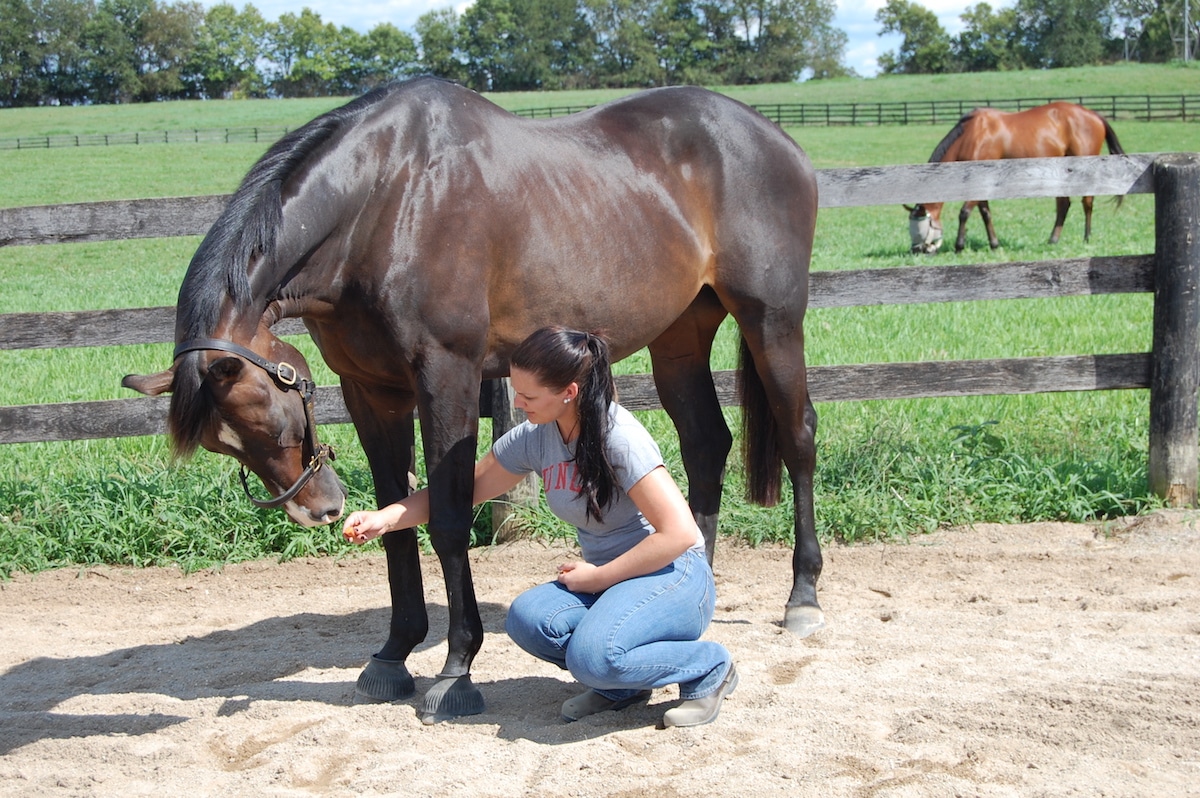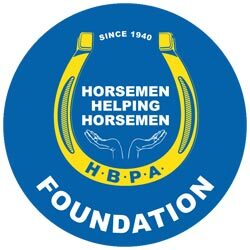How to help your OTTB develop a beautiful neck and back

Ground exercises such as carrot stretches can encourage your horse to lift his back and use his topline properly. Courtesy The Horse staff
You know it when you see it — the wither that appears more angular than normal, the sunken-in loins. Yet nowhere else does the horse appear underweight. It’s a topline that’s lacking, and we nutritionists often see it in Thoroughbreds coming off the track or entering a training program after layup. Making a few dietary and conditioning adjustments can help improve your OTTB’s back musculature and ensure he reaches his performance potential. Here’s how.
Topline Physiology
To understand how to improve a horse’s topline, we must first understand what it comprises. The topline is essentially what it sounds like — it follows the vertebrae of the horse’s spine, starting over the withers at the base of the neck, running straight down the back and all the way to the croup (over the hindquarters). Three skeletal muscle groups support this area of the spine: the trapezius muscle, the latissimus dorsi and the longissimus dorsi. The trapezius muscle connects the neck to the scapula, or shoulder blade, and extends over the withers. Next, the latissimus dorsi extends from the humerus (below the shoulder blade) over the rib cage to the spine. Last but not least, the longissimus dorsi — the largest muscle in the horse’s back that allows the spine to flex laterally — extends from the base of the neck, just in front of the withers, all the way to the pelvis.
Although muscle makes up most of a horse’s topline, subcutaneous (just under the skin) fat plays a supporting role (muscle is about 73 percent protein and 22 percent fat). Assessing your OTTB’s body condition score (BCS) — an evaluation of fat coverage on a scale of one to 10 — will help you determine where to start improving topline. Appearances can be deceiving; a horse’s topline might seem ideal when, in reality, it lacks proper strength and muscling. In other words, he might have enough fat cover over his neck and ribs but need to develop more topline muscle with diet and exercise. On the other end of the spectrum, a horse with a weak-looking topline in addition to inadequate fat cover over the neck and ribs could simply need a boost in calories.
What is topline muscle made of? Protein, of course! All protein in the body is made up of different combinations of amino acids, 10 of which are essential (meaning they must be provided for in the diet). If a horse’s diet does not provide adequate amounts of lysine, known as the first limiting amino acid, it limits his ability to synthesize protein, no matter how much of the other nine amino acids is present.
Diet’s Role
Simply increasing the percentage of crude protein (denoted on the feed bag or tag) in your OTTB’s diet will only go so far in building his topline. You must provide feeds that contain good-quality, digestible sources of essential amino acids for horses, such as alfalfa, most spring pasture and soybean oil.
“One of the first things I do when bringing home an OTTB is make sure they have 24/7 access to high-quality alfalfa,” says Elisa Wallace, five-star three-day event rider, American mustang advocate and winner of the 2018 Thoroughbred Makeover Eventing division with Reloaded, who went on to be crowned America’s Most Wanted Thoroughbred. In terms of concentrates and supplements, “I have found the combination of senior feed, along with a ration balancer and an extruded fat supplement, can pack the biggest punch in the fight to build a topline.”
Wallace says the senior product she feeds is designed to help aid nutrient absorption and digestion, the supplement to increase calorie intake while keeping feed volume down and the ration balancer to provide additional amino acids and proteins.
“I tend to play around with the ration and see what the horse responds to the best,” she says. “But my go-to (based on my horse’s body weight) is feeding roughly 4 pounds of ration balancer and 2 pounds of fat, with 6 pounds of senior feed throughout the day.”
Wallace says she divides up these amounts into small feedings (around 3 pounds each meal). As each horse gains weight and his or her metabolism stabilizes, she slowly cuts back on the amount of feed, depending on his workload and body condition.
Exercise’s Role
Topline is key to top performance. Weakness in this area can impede a horse’s ability to track up, jump or gallop. All horses have a set number of muscle fibers; they can’t make more, but they can strengthen and condition the muscle they have. Enter proper training and exercise protocols. On the ground, simple exercises such as “carrot stretches,” where you encourage your horse to lift his back by stretching toward his chest, knees, fetlocks and left or right elbow and hip, can help him use his topline properly. Longeing over poles or cavalettis while encouraging your horse to drop his head can help strengthen the back.
Under saddle, you want your horse to move in a long and supple manner to strengthen the core muscles along his back and neck region. In fact, researchers agree that every riding or training session should begin with a longitudinal flexion (with the neck downward and outward) warmup that stretches and extends the horse’s back and topline. This loosens the muscles and might initiate a relaxed state in the horse. In an unpublished study done in Norway in 2017 using a standardized method of longitudinal stretching of the topline while riding with long reins, researchers found that horses in training demonstrated increased stride length, reduced pressure response and positive behavioral responses. Working up and down hills, either while riding or on a longe line, also helps condition topline and hindquarter muscles.
Other Factors
A weak topline sometimes indicates other health problems. Generally speaking, OTTBs coming directly off the track are accustomed to high-volume, high-starch diets and have been stalled continuously, both of which can lead to gastric ulcers and hindgut (large intestine and colon) upset. One of the most common reasons Wallace says she’s seen poor toplines among her OTTBs due to gastric ulcers and hindgut inflammation.
When horses are suffering from gastric ulcers and/or intestinal inflammation, they cannot properly digest, process and absorb nutrients. This also affects important hormones such as cortisol and insulin, resulting in the horse’s inability to build muscle, including over the topline.
Along with her feeding regimen, Wallace treats her horses for gastric ulcers using omeprazole prescribed by her veterinarian.
Poor conformation, age and injury can also negatively affect an OTTB’s topline. Muscle wasting can occur naturally with age or with a decrease in exercise, which can happen with injury and stall rest. Pain, especially due to poor saddle fit or improper vertebral alignment, can also reduce topline.
OTTB Topline Tips
- As with any skeletal muscle, a combination of diet and exercise affects topline development and maintenance.
- Use body condition scoring to assess fat coverage and tweak the diet for a better topline.
- Work with an equine nutritionist or veterinarian to assess your horse’s protein quality and quantity, specifically that of the essential amino acids necessary to build muscle.
- Incorporate a high-quality protein source, such as alfalfa hay, or a ration balancer.
- Five-star eventer and 2018 Makeover winner Elisa Wallace suggests breaking up feedings into multiple small meals so the horse’s stomach can digest the nutrients in his feed and supplements more easily.
- At least 90 percent of all Thoroughbred racehorses have gastric ulcers, so work with your veterinarian to diagnose and treat your OTTB.
- Consult a professionally trained saddle fitter to ensure your saddle isn’t causing pain or discomfort.
- “I also make sure my horse’s feet are properly balanced by using a good farrier, and they are seen by a chiropractor and massage therapist prior to starting light work, such as hacking on trails and flatwork, to help them engage the proper muscles for building their topline,” says Wallace.
- Incorporate plenty of groundwork and under-saddle training that encourages your OTTB to stretch long and low, working the muscles in the topline and hindquarters.
This article was originally published in the Spring 2019 issue of Off-Track Thoroughbred Magazine, the only publication dedicated to the Thoroughbred ex-racehorse in second careers. Want four information-packed issues a year delivered to your door or your favorite digital device? Subscribe now!

